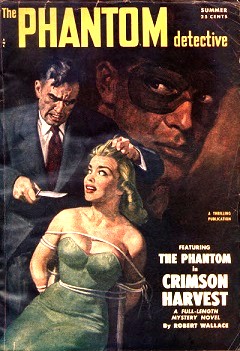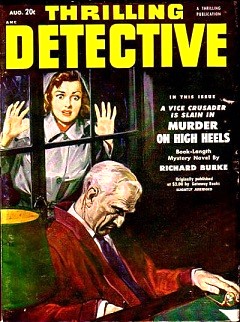
 The Whisperer (1951) aired “Into Each Life” on August 19, 1951 as the eighth of its 13 episodes. This episode is only the third we have showcased since the first back in October of 2022 (the second being in February of this year), so a reprise of the introductory material from the previous episodes is in order for newcomers.
The Whisperer (1951) aired “Into Each Life” on August 19, 1951 as the eighth of its 13 episodes. This episode is only the third we have showcased since the first back in October of 2022 (the second being in February of this year), so a reprise of the introductory material from the previous episodes is in order for newcomers.
The man known as the Whisperer is in reality one Philip Galt, a lawyer who was in a terrible accident in which his vocal chords were crushed. He used this strange disability as a cover to infiltrate the organized crime Syndicate in Central City, passing on to this local crime affiliate their next crime or proposed illegal operation from the Syndicate’s national bosses in New York. Upon completion of a successful operation by Dr. Benjamin Lee and his nurse Ellen Norris that returned his voice, Galt decided to continue his undercover role as the Whisperer, setting up the local Syndicate branch and then foiling their crimes and getting them arrested, convicted, and behind bars as lawyer Philip Galt. Ellen Norris is now Galt’s assistant and love interest and is the only one who knows Galt doubles as the Whisperer.
Philip Galt/The Whisperer was played by Carleton G. Young (1907-1971, photo top right). He appeared in a number of radio shows, had roles in a number of films, and did quite a few TV shows into the early 60s.
This episode has the main Syndicate headquarters in New York calling their contact in Central City, the Whisperer, and giving him their newest assignment—the murder of a local nightclub owner who refuses to sell out to the Syndicate. They’ve brought in one of their hired killers to get in touch with the Whisperer to set up the hit. This is an important case for the Syndicate, for their first seven attempts to kill the nightclub owner have failed, and this time they let the Whisperer know that failure is not an option. One of the most intriguing elements of these stories is how the Whisperer plays both sides of the law without the Syndicate figuring out his alter identity of Philip Galt, lawyer, who uses his inside knowledge gained as the Whisperer to use the law to defeat the bad guys. This fence-balancing act is put to the test here, as the imported hit man notices that, curiously enough, Philip Galt seems to somehow figure in the Syndicate’s defeat every time, but is not sure how. So he devises a dual-purpose plan using a pretty woman (his beautiful partner in crime) to lure Galt into a trap—a scenario where not only is Galt removed from the picture for good but is framed for the murder of the nightclub owner. How the Whisperer overcomes this wily plan is at the heart of the story, for discovering how he retains his secret identity and thwarts the hit man’s efforts is worth a listen.
Play Time: 29:10
{Airing on a late Sunday afternoon in mid-August of 1951, the neighborhood gang could hardly wait for the next morning to swarm the local newsstand in hopes of discovering new issues (or those not yet acquired) of their favorite magazines. After all, summer vacation would soon be at an end, making every visit to their home away from home even more memorable. The Phantom Detective (1933-53) began as an answer to the success of The Shadow magazine. Due to scheduling differences it didn’t end up publishing quite as many issues as the pulp it was modeled after, but it ran for a longer length of time, making it the longest-running single-character pulp of all time. It was a quarterly in 1951. Super Science Stories (1940-43, 1949-51), while not a major player in the field, yet managed to publish quite a few of the biggest, most popular names in the field at the time, a few of which were L. Sprague de Camp, Henry Kuttner, Ray Bradbury, Murray Leinster, Fredric Brown, A. E. Van Vogt, and Poul Anderson. It was a bi-monthly in 1951, with the cover below heralding its final issue. Thrilling Detective (1931-53) ran detective fiction that appealed to a wide swath of the detective/mystery audience and was able to maintain a monthly schedule for almost all of its long run, drawing down to a bi-monthly schedule shortly after WW II, and ending with its final pair of issues in 1953 (Summer and Fall) as quarterlies.}
[Left: Phantom Detective, Summer/51 – Center: Super Science, 8/51 – Right: Thrilling Detective, 8/51]



To view the entire list of weekly Old Time Radio episodes at Tangent Online, click here.